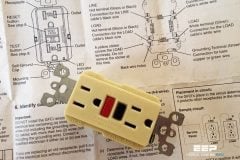
Ohm’s Law also makes intuitive sense if you apply it to the water-and-pipe analogy. If we have a water pump that exerts pressure (voltage) to push water around a ”circuit” (current) through a restriction (resistance), we can model how the three variables interrelate.
If the resistance to water flow stays the same and the pump pressure increases, the flow rate must also increase.
| Pressure = Increase | Voltage = Increase |
| Flow rate = Increase | Current = Increase |
| Resistance = Same | Resistance = Same |

If the pressure stays the same and the resistance increases (making it more difficult for the water to flow), then the flow rate must decrease:
| Pressure = Same | Voltage = Same |
| Flow rate = Decrease | Current = Decrease |
| Resistance = Increase | Resistance = Increase |

If the flow rate were to stay the same while the resistance to flow decreased, the required pressure from the pump would necessarily decrease:
| Pressure = Decrease | Voltage = Decrease |
| Flow rate = Same | Current = Same |
| Resistance = Decrease | Resistance = Decrease |

Review of Water-and-Pipe Analogy for Ohm’s Law
- With resistance steady, current follows voltage (an increase in voltage means an increase in current, and vice versa).
- With voltage steady, changes in current and resistance are opposite (an increase in current means a decrease in resistance, and vice versa).
- With current steady, voltage follows resistance (an increase in resistance means an increase in voltage).
Resource: Lessons in electric circuits , Volume I – DC











Thanks. I’m currently doing electronics and have to say about Ohm’s law for homework. I really want to take electronics for GCSE, but you have to be in level 7/8 maths sets :(. I am still quite good at maths and reckon I will take higher maths as I am having tuition to up my grades. I might be able to (fingers crossed) convince my school to let me take electronics, hopefully it will work. Thanks for the info though, one of the most simple and clear explanations I have seen yet.
voltage is proportional to current is the law of ohms but here current depends upon the conductor resistance.
ohm’s law states that at constant resistance voltage is directly proportional to current .you missed the resistance yaar